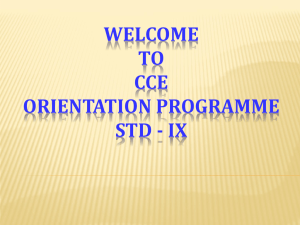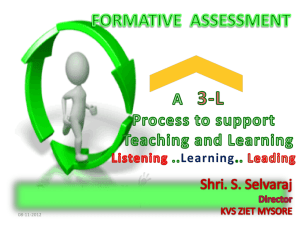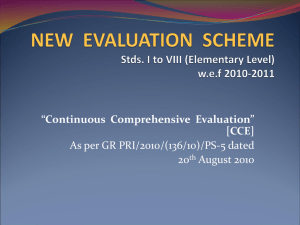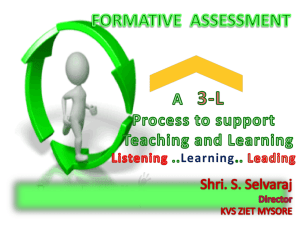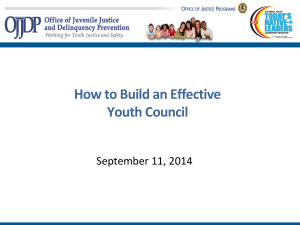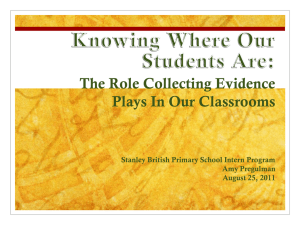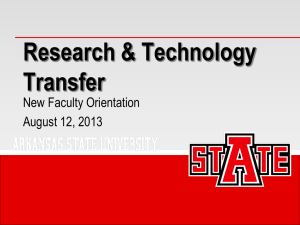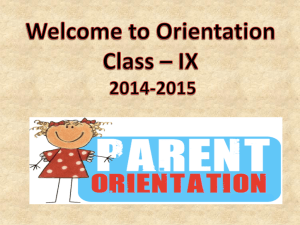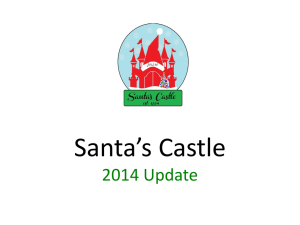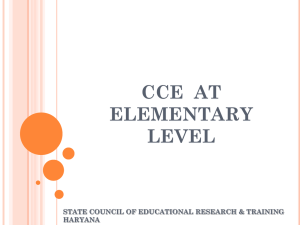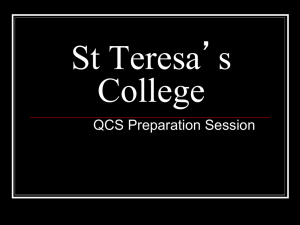What is Evaluation? - Arkansas State University
advertisement
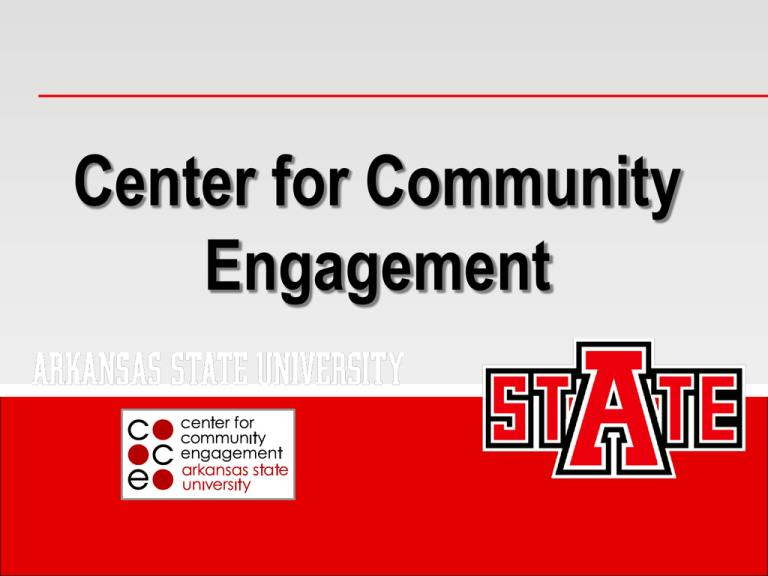
Center for Community Engagement Office of Behavioral Research and Evaluation Who We Are Becky Brittany Christy Eleny Phyllis Trisha Brief History Where we began (small evaluation office in Education) How we evolved to where we are now So, where/what are we now? CCE … Is a centralized resource for faculty and students at ASU Provides a means to interact and work with university units and faculty and with the broader community through partnerships OBRE… Is a centralized resource for education faculty and their partners across colleges, schools, centers, co-ops, etc. Provides consultation for and evaluation of educationally-related programs What is our purpose? To foster activity at ASU collaboration at ASU program development community partnerships opportunities to engage in society in meaningful ways an exchange of resources for mutual benefit multi-faceted outreach for the community at large What We Do Examples of CCE’s Work Training PBIS Grant Writing Grant Writing DFC Youth Drug Court Evaluation & Research SOC Beck PRIDE ELF FYE iPad Initiative Consultation & Program Development College of Education Out of the Dark STEM Service Learning/Research Instrument Development ERZ Asset Mapping © instrument for Wraparound (AR) Cultural and Linguistic Competence Examples of Past Collaborations Recent Past LIFT Second Chance Out of School Network ACTION for Kids REACH BRAD Jonesboro Auditorium Commission ERZ DFWC CCC Rural and Delta STEM Centers How We Operate With Whom? In What Ways? How is the Work Funded? What Is It That We Do? We help write grants We help develop programs We help evaluate programs We help develop plans We develop training We map assets & analyze needs We do research We help make schools safer We help students achieve We don’t do floors or dishes We work for coffee, tea, & chocolate Email: cce@astate.edu Website: cce.astate.edu 2013 Institute for Research Development May 16, 2013 The Story Line In the grant development system, the submitters are represented by two separate, yet equally important groups. The program directors who implement the program and the evaluators who assess the implementation. These are their stories. (with apologies to Law and Order) First Question to Ask Yourself Why does your project deserve money? Who will benefit from your work? How? Will you be a good steward of the money? How do we know the money was worth it? How will you know if you accomplished anything? What You Will Learn Today Evaluation Needs Why logic models are important Institute for Research Development WHAT IS EVALUATION & WHY DO WE NEED IT? What is Evaluation? “Evaluation is a systematic process to understand what a program does and how well the program does it.” http://www.cdc.gov/healthycommunitiesprogram/tools/pdf/eval_planning.pdf What is Evaluation? (continued) Evaluation is… Measurement Assessment Data collection What is Evaluation? (continued) Evaluation is… Making sure your activities are moving forward as they should Making sure you will accomplish something Letting others know if you succeeded What is Evaluation? (continued) Evaluation should… be the core of your project challenge your project implementation assess your program, organization, or plan help you decide how to proceed What is Evaluation? (continued) Types of evaluation Process—monitoring procedures & implementation Is activity or program progressing Schedule of activities Attendance at meetings Articles published What is Evaluation? (continued) Formative Assessing efforts to allow revision Strengths Weaknesses Progress What is Evaluation? (continued) Outcome (Summative) Did project/activity work Short term Accomplish objectives Change knowledge/attitudes/behavior What is Evaluation? (continued) Impact Long-range results Broader target (e.g., community-level, school-level) Evaluation Model Example Impact evaluation Scope Outcome evaluation Process evaluation Impact evaluations are broader and assess the overall or net effects—intended or unintended— of the program as a whole.* Outcome evaluations investigate whether the program causes demonstrable effects on specifically defined target outcomes.* Process evaluations investigate the process of delivering the program, focusing primarily on inputs, activities, and outputs.* Performance Measurement Program Monitoring Time * Evaluation definitions excerpt from: Trochim, William M. The Research Methods Knowledge Base, 2nd Edition. Internet WWW page, at URL: <http://trochim.human.cornell.edu/kb/index.htm> (version current as of Aug. 02, 2000). 26 Steps in Evaluation (Programs) http://learningstore.uwex.edu/assets/pdfs/G3658-1W.PDF So Why do We Need Evaluation? To show that the money spent was worthwhile To provide evidence that your project works (e.g., for future funding) Who Expects You to do Evaluation? Everyone Government (NSF, NIH, SAMSHA, DoE, HUD, DoJ,…) Foundations Example--NSF Online Evaluation Resource Library (oerl.sri.com) Project Outcomes Report for the General Public (same goals as evaluation) (www.nsf.gov/pubs/policydocs/porfaqs.jsp) Example—SAMHSA SAMHSA grantees are required to collect and report … data …under the Government Performance and Results Act (GPRA) … Performance data will be reported to the public, the Office of Management and Budget (OMB) and Congress as part of SAMHSA’s budget request. Example—SAMHSA cont’d Grantees must … review … performance data …. The assessment should…help you determine whether you are achieving the goals, objectives and outcomes you intend to achieve and whether adjustments need to be made to your project. You will be required to report on your progress achieved, barriers encountered, and efforts to overcome these barriers… Example—Project Intercept SO… WHAT DO PEOPLE DO FOR EVALUATION? Evaluation Examples Differs across fields Formative types Monitor meetings Monitor timeline CQI Needs assessment Asset mapping Strengths and weaknesses (or SWOT) Evaluation Examples Summative Behaviors Attitudes Knowledge Costs (cost-benefit) Policies Institutional changes Ideally want “counts” Caveat Formative & Summative just heuristics What is what? Depends on project & funding agency Summative can be formative when used within project delivery Formative can be summative when used as outcome Needs assessment often needed in advance of project Example—ELF Program Formative evaluation--quantitative Goal #1: Increase retention of freshman STEM majors, especially those students from underrepresented groups. Use demographic and other information (e.g., financial eligibility) to count the number of freshman from underrepresented groups from the Ark-LSAMP program. Count the number of freshmen that start in the ELF Program who progress to the sophomore year. Goal #2: Provide faculty and peer mentoring to students in the ELF Program Count the number of upper-division students in the ELF Program who become team leaders for research projects. Count the number of faculty mentors for each student in the ELF Program. Example—ELF Program cont’d Formative Evaluation cont’d : Additional assessments for student and program portfolios Monitor student grades (as a measure of achievement). Monitor progress toward graduation (as a measure of achievement). Measure student interest, involvement, and investment using surveys and focus groups each spring to assess student opinions, attitudes, and suggestions for program improvement. Example—ELF Program cont’d Summative Evaluation Less emphasis Sum of formative e.g., graduation rate by year summed across years Example—Project HOPE Asset Mapping Summary as Summative Product HOW DO YOU DETERMINE WHAT YOUR EVALUATION SHOULD BE? Virtually All Projects Must Have… Goals (abstract, what do you want to accomplish?) Objectives (concrete, measureable components of goals) Outcomes (optional, measured result) Objectives or Outcomes are what you evaluate Goals are determined by inferences Example Goal: Improve math achievement Objective: Increase understanding of algebra Outcome: Student performance on end-of-course exams will increase by 10% OR Goal: Improve math achievement Objective: Increase student performance on end-of-course exams Evaluation Data Also need to know… What kind of data will you collect? How will they be analyzed? To whom will they be reported? Data Collection, Analysis, & Reporting Types of Data Record Review Data Surveys Interviews Focus Groups Measurements Tests Behaviors Data Collection, Analysis, & Reporting (cont.) Say you will measure only things you can measure Examples of saving the world and failing in your outcomes Increase self esteem Too hard to define (baseline vs. barometric?) Too hard to measure (Rosenberg’s classic) Too hard to change Improve family functioning What does it mean? Increase collaboration—Huh? Increase achievement scores Designed to be stable General tests have too many different items, your program needs to target all those items Norm- vs. criterion-referenced Increase student involvement Data Collection, Analysis, & Reporting (cont.) How will you analyze the data? Pre-Post? More frequent intervals? Fewer intervals? What assumptions will be made? Data Collection, Analysis, & Reporting (cont.) To whom will you report the data? Funding Agency (that’s a given) Stakeholders? Community? Participants? Possible future funders? Assume you need to report at many levels. EVALUATION VERSUS RESEARCH Evaluation versus Research Evaluation differs from ‘research’ minimally Most often for programs Often not generalizable knowledge (but often is!) Both focus on assessment & measurement Evaluation versus Research RESEARCH QUESTION HYPOTHESIS REPLICATE & EXTEND RESEARCH REPORT THE RESULTS PREDICTIONS PROCESS RESEARCH METHOD ANALYZE RESULTS & DRAW CONCLUSIONS EXPERIMENT Evaluation versus Research PROGRAM GOAL OBJECTIVES MODIFY…REPLICATE… & EXTEND EXPECTED EVALUATION OUTCOMES PROCESS REPORT THE RESULTS PROGRAM IMPLEMENTATION ANALYZE RESULTS & DRAW CONCLUSIONS EVALUATION Elements of an Evaluation Design from Agency for Toxic Substances & Disease Registry, CDC) 1. 2. 3. 4. 5. 6. 7. 8. Statement of objectives Definition of data to be collected Methodology Instrumentation Data Collection Data Processing Data Analysis Report LOGIC MODELS: ROADMAP FOR PROGRAMS Logic Model Example: Water quality University of Wisconsin Extension http://www.uwex.edu/ces/pdande/evaluation/evallogicmodel.html Logic Models (Benefits from OJJDP:http://www.ojjdp.gov/grantees/pm/logic_models_understanding.html) Why Create a Logic Model? Identify program goals, objectives, activities, and desired results Clarify assumptions and relationships between program and expected outcomes Communicate key elements of program Help specify what to measure in evaluation Guide assessment of underlying project assumptions and promotes self-correction Logic Models (OJJDP Info: http://www.ojjdp.gov/grantees/pm/Logic_models_safeplay1.pdf) Every day logic model : Family Vacation Family Members Drive to state park Budget Set up camp Car Camping Equipment INPUTS Cook, play, talk, laugh, hike OUTPUTS University of Wisconsin Extension http://www.uwex.edu/ces/pdande/evaluation/evallogicmodel.html Family members learn about each other; family bonds; family has a good time OUTCOMES Logic Models: Kellogg Foundation Guide http://www.compact.org/wp-content/uploads/2010/03/LogicModelGuidepdf1.pdf Logical chain of connections showing what the program is to accomplish INPUTS OUTPUTS Program investments Activities What we invest What we do Participation Who we reach OUTCOMES Short Medium What results University of Wisconsin Extension http://www.uwex.edu/ces/pdande/evaluation/evallogicmodel.html Longterm How will activities lead to desired outcomes? A series of if-then relationships Tutoring Program Example IF We invest time and money then IF We can provide tutoring 3 hrs/week for 1 school year to 50 children then Students struggling academically can be tutored IF then IF They will learn and improve their skills then IF They will get better grades University of Wisconsin Extension http://www.uwex.edu/ces/pdande/evaluation/evallogicmodel.html then They will move to next grade level on time Generic Logic Model (OJJDP: http://www.ojjdp.gov/grantees/pm/generic_logic_model.pdf) Logic Model Used in Evaluation of the Children At Risk Program From the Urban Institute via USDOJ: http://www.ojp.usdoj.gov/BJA/evaluation/guide/documents/evaluation_strategies.html#p6 Parent Education Program – Logic model SITUATION: During a county needs assessment, majority of parents reported that they were having difficulty parenting and felt stressed as a result INPUTS Staff Money Partners Research OUTPUTS Assess parent ed programs Designdeliver evidencebased program of 8 sessions Facilitate support groups OUTCOMES Parents increase knowledge of child dev Parents of 3-10 year olds attend Parents better understanding their own parenting style Parents gain skills in new ways to parent Parents identify appropriate actions to take Reduced stress Improved child-parent relations Parents use effective parenting practices Parents gain confidence in their abilities University of Wisconsin Extension http://www.uwex.edu/ces/pdande/evaluation/evallogicmodel.html www.ojjdp.gov/dmc/tools/dmcpresentations1_17_06.ppt 66 BACK TO EVALUATION Planning your Evaluation Know your solicitation Know your Goals & Objectives Answer 2 questions 1. How will you know your project is on the right track? 2. How will you know your project was effective? Don’t forget dissemination plan. General Heuristics for Success Pay attention to solicitation Keep multi-methods in mind Most organizations like reports that provide… 3 bullet points, a graph, & a quote Provide some quantitative & some qualitative stuff some objective & some subjective data General Heuristics for Success Operationally define concepts in advance Don’t try to change the world, maybe just some measureable behaviors Pick measures/outcomes that literature shows can be changed Promise basics, add value Objective better than subjective e.g., caregivers think family improved, children still have behavioral problems & going to jail—latter matter Include evaluator from beginning. Fin, Finito, Ende Questions? Thank You! David A. Saarnio, Ph.D. Christy J. Brinkley, Ed.S. Center for Community Engagement Arkansas State University Phone: 870-680-8420 Fax: 870-972-3071 dsaarnio@astate.edu cbrinkley@astate.edu cce@astate.edu Email: cce@astate.edu Website: cce.astate.edu
